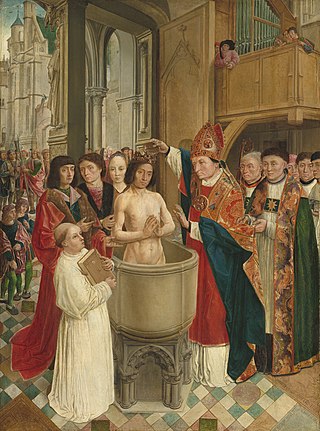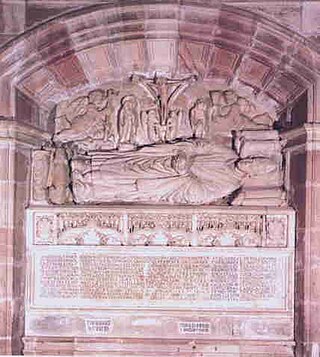Related Research Articles
Pope Nicholas I, called Nicholas the Great, was the bishop of Rome and ruler of the Papal States from 24 April 858 until his death. He is remembered as a consolidator of papal authority, exerting decisive influence on the historical development of the papacy and its position among the Christian nations of Western Europe. Nicholas I asserted that the pope should have suzerainty over all Christians, even royalty, in matters of faith and morals.

Johann Cochlaeus (Cochläus) was a German humanist, music theorist, and controversialist.

The Synod of Elvira was an ecclesiastical synod held at Elvira in the Roman province of Hispania Baetica, now Granada in southern Spain. Its date has not been exactly determined but is believed to be in the first quarter of the fourth century, approximately 305–6. It was one of three councils, together with the Synod of Arles (314) and the Synod of Ancyra, that first approached the character of general councils and prepared the way for the first ecumenical council. It was attended by nineteen bishops and twenty-six presbyters, mostly resident in Baetica. Deacons and laymen were also present. Eighty-one canons are recorded, although it is believed that many were added at later dates. All concern order, discipline and conduct among the Christian community. Canon 36, forbidding the use of images in churches, became a bone of contention between Catholic and Protestant scholars after the Protestant Reformation.

Hincmar, archbishop of Reims, was a Frankish jurist and theologian, as well as the friend, advisor and propagandist of Charles the Bald. He belonged to a noble family of northern Francia.
Gottschalk of Orbais was a Saxon theologian, monk and poet. Gottschalk was an early advocate for the doctrine of two-fold predestination, an issue that ripped through both Italy and Francia from 848 into the 850s and 860s. Led by his own interpretation of Augustine's teachings on the matter, he claimed the sinfulness of human nature and the need to turn to God with a humility for salvation. He saw himself as a divine vessel calling all of Christianity to repent for decades of Civil War. His attempts of this new Christianisation of Francia ultimately failed, his doctrine was condemned as heresy at the 848 council of Mainz and 849 council of Quierzy. Following his conviction as a heretic Gottschalk remained stubborn to his ideology disobeying the ecclesiastical hierarchy, making him an "actual heretic in the flesh", for this disobedience Gottschalk was placed in monastic confinement; however the shockwaves his ideology sent around Western Christendom refused to stop reverberating, Gottschalk managed to win over more followers and the threat remained up until his death in 868.
Anastasius Bibliothecarius or Anastasius the Librarian was bibliothecarius and chief archivist of the Church of Rome and also briefly a claimant to the papacy.
Several councils were held at Quierzy, a royal residence under the Carolingians, but now an insignificant village on the Oise in the French Department of Aisne in Picardy. The synod of September 838, ordered the monks of the abbey of Saint-Calais in the Diocese of Le Mans to return to their monastery, from which they falsely claimed to have been expelled by their bishop. It also condemned some of the liturgical opinions of Amalarius of Metz.
The Council of Epaone or Synod of Epaone was held in September 517 at Epaone in the Burgundian Kingdom.

Remigius was the Bishop of Reims and "Apostle of the Franks". On 25 December 496, he baptised Clovis I, King of the Franks. The baptism, leading to about 3000 additional converts, was an important event in the Christianization of the Franks. Because of Clovis's efforts, a large number of churches were established in the formerly pagan lands of the Frankish empire, establishing a distinct Catholic variety of Christianity for the first time in Germanic lands, most of whom had been converted to Arian Christianity.
The Councils of Carthage were church synods held during the 3rd, 4th, and 5th centuries in the city of Carthage in Africa. The most important of these are described below.
The Helvetic Consensus is a Swiss Reformed profession of faith drawn up in 1675 to guard against doctrines taught at the French Academy of Saumur, especially Amyraldism.

Tilpin, Latin Tilpinus, also called Tulpin, a name later corrupted as Turpin, was the bishop of Reims from about 748 until his death. He was for many years regarded as the author of the legendary Historia Caroli Magni, which is thus also known as the "Pseudo-Turpin Chronicle". He appears as one of the Twelve Peers of France in a number of the chansons de geste, the most important of which is The Song of Roland. His portrayal in the chansons, often as a warrior-bishop, is completely fictitious.

Bernard of Sédirac, also known as Bernard of Agen or Bernard of Le Sauvetat, was the metropolitan archbishop of Toledo from 1086 and first primate of Spain from 1088 to his death. His significance in the history of Spain lies in the fact that during his episcopate the church of Castile and León emerges from its isolation.

The Archdiocese of Lyon, formerly the Archdiocese of Lyon–Vienne–Embrun, is a Latin Church metropolitan archdiocese of the Catholic Church in France. The archbishops of Lyon serve as successors to Saints Pothinus and Irenaeus, the first and second bishops of Lyon, respectively, and are also called primates of Gaul. He is usually elevated to the rank of cardinal. Bishop Olivier de Germay was appointed archbishop on 22 October 2020.

Prudentius was bishop of Troyes, a chronicler and an opponent of Hincmar of Reims in the controversy on predestination.

The former French Catholic diocese of Die existed from the fourth to the thirteenth century, and then again from 1678 to the French Revolution. It was suppressed by the Concordat of 1801, its territory being assigned to the diocese of Grenoble. Its see was the Cathedral of the Assumption in Die.

Johannes Piscator was a German Reformed theologian, known as a Bible translator and textbook writer.

Clerici vagantes or vagabundi is a medieval Latin term meaning "wandering clergy" applied in early canon law to those clergy who led a wandering life either because they had no benefice or because they had deserted the church to which they had been attached.
Amulo Lugdunensis served as Archbishop of Lyon from 841 to 852 AD. As a Gallic prelate, Amulo is best known for his letters concerning two major themes: Christian–Jewish relations in the Frankish kingdom and the Carolingian controversy over predestination. He was ordained as archbishop in January 841.

Louis Tronchin was a Genevan Calvinist theologian and the son of Théodore Tronchin.
References
- Bouquet, Recueil, viii. 388 sqq.;
- Ceillier, Auteurs sacres, xii. 614 sqq.;
- Acta Sanctorum , October, xii. 878 sqq.;
- Hist. littéraire de la France, v. 449 sqq.
![]() This article incorporates text from a publication now in the public domain : Jackson, Samuel Macauley, ed. (1914). New Schaff–Herzog Encyclopedia of Religious Knowledge (third ed.). London and New York: Funk and Wagnalls.
This article incorporates text from a publication now in the public domain : Jackson, Samuel Macauley, ed. (1914). New Schaff–Herzog Encyclopedia of Religious Knowledge (third ed.). London and New York: Funk and Wagnalls.{{cite encyclopedia}}: Missing or empty |title= (help)